DominionSections
Browse Articles
- IndependentMedia.ca
- MostlyWater.org
- Seven Oaks
- BASICS Newsletter
- Siafu
- Briarpatch Magazine
- The Leveller
- Groundwire
- Redwire Magazine
- Canadian Dimension
- CKDU News Collective
- Common Ground
- Shunpiking Magazine
- The Real News
- Our Times
- À babord !
- Blackfly Magazine
- Guerilla News Network
- The Other Side
- The Sunday Independent
- Vive le Canada
- Elements
- ACTivist Magazine
- The Tyee
- TML Daily
- New Socialist
- Relay (Socialist Project)
- Socialist Worker
- Socialist Action
- Rabble.ca
- Straight Goods
- Alternatives Journal
- This Magazine
- Dialogue Magazine
- Orato
- Rebel Youth
- NB Media Co-op
Radio
Arrested Developments
September 30, 2004
Arrested Developments
New York hosts Republicans... and the largest US demonstration in decades
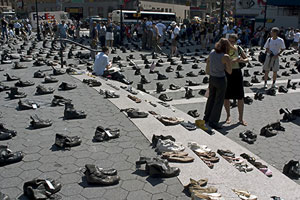
Demonstrators lay pairs of shoes to symbolize Iraqi and US casualties of war. all photos: NYC Indymedia
Thus remarked Brad Freeman, a Republican delegate from LA, and friend of George W. Bush, regarding the several hundred thousand protestors who flooded Manhattan on Sunday, August 29, the eve of the Republican National Convention."
Given the scale and volume of the demonstrations that unfolded on the streets of NYC during the week of the convention, it was quite an understatement---although one would hardly know that from the scant coverage the anti-GOP demos received in the Canadian mainstream media.
The organizers United For Peace and Justice estimated that over half a million marched that day under the banner "The World Says No to the Bush Agenda"; the number was greater than they had expected. Despite a number of fear-mongering articles about the dangerous protestors descending on the city in the local New York press, it was the largest march that New York City had seen in 20 years.
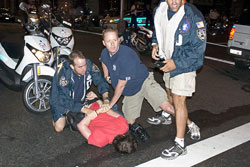
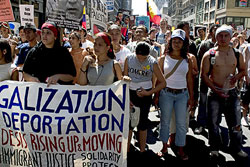
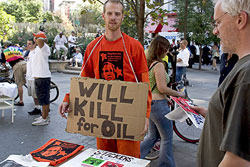
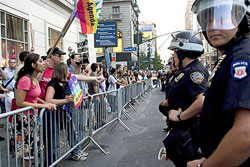
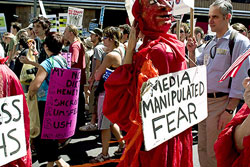
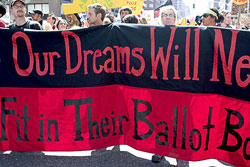
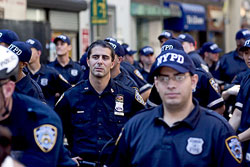
photos: NYC Indymedia
The march was joined by "Stone Walk," a group that had come all the way from Boston pulling a 1400 lb granite memorial honouring the "Unknown Civilians Killed in the War."
I talked to a member of the group "Koreans who oppose the US war and occupation" and he told me that the group was protesting because "we want to show that as people of colour, we oppose aggressive wars throughout the world." A number of placards read "the mission is not accomplished" and highlighted the US military's prisoner abuse scandals.
For Bill Smith, a member of School of the Americas Watch (SOAW), the recently publicized prisoner torture was nothing new. "We've been saying for years that [torture] has been part of government policy," said Smith. SOAW has for years been pressuring the US government to shut down its military training institute in Fort Benning, Georgia, which is notorious for training Latin American death squad leaders.
Some Republican officials responded to the Sunday demo by connecting the demonstrators with Democrats, in an effort to paint Kerry as non-mainstream. There was a sprinkling of "Vote Kerry" buttons in the crowd.
However, at the heels of the standard protest chant of the day"No Bush!" one often heard shouts of "Or Kerry!" tacked on, exposing the most prominent of many differences between demonstrators.
On the streets, in panel discussions, and between marches, there were heated discussions about the ultimate goal of the demonstrations--about whether it was to "re-defeat" Bush, or something more. At an August 30 panel discussion "Can we do any better than anyone but Bush?", Democracy Now's Jeremy Scahill argued that Kerry is really no alternative because he is not anti-war, and not opposed to the attack on civil liberties associated with the war on terror. At the same event, Canadian journalist Naomi Klein made the case to Americans that it would be an international disgrace for the nation to reelect Bush.
At a panel discussion on the corporate media the week before, one audience member, excited at what he saw as broader implications of the emerging social and political movement against Bush, was interrupted by fierce retorts from a fellow audience member, who decried any kind of radical protest tactic that could be spun by Republican propaganda mills into pro-Bush propaganda. "Not until after the election!" he screamed. This prompted a long-winded response from an anarchist, who began: "No! We need to overthrow the capitalist system..."
The week was crammed full with protest actions. There were various marches--from the "Still We Rise" people of colour's march, to a women's rights march, to an immigrant workers' rights march, to a poor people's march. The latter event ended in a scuffle between a police officer on a scooter and a protestor, which the media covered extensively (after a week of well-behaved protests, the scuffle was one of the few instances of the much-anticipated "violence").
A tent city christened "Bushville" was set up in Brooklyn to emphasize the negative social impact of the Bush administration's policies while activists confronted Republican delegates in the streets, and around theatres and hotels.
While heavily patrolled police barricades made it difficult for any protests to get within a radius of three blocks of Madison Square Garden, several demonstrators managed to infiltrate the convention. Particularly successful were the activists from Code Pink, an anti-war women's organization which uses the symbol of the pink slip (they often wear a pink slip--the garment--while protesting) to highlight job losses under Bush, and to call for his dismissal. By sending brigades of attractive women from within their ranks to woo male Republican delegates at bars, Code Pink managed to obtain a number of guest passes.
Alongside the numerous marches, there were a number of less conventional protest events, including anti-Bush street theatre performances and art shows.
Anyone within a two block radius of ground zero on August 28 would have heard the eerie chiming and tolling of hundreds upon hundreds of bells. The ringing filled the air just before dusk, as hundreds of people walked around the pit where the World Trade Centre had been prior to September 11, 2001, in "Ring Out," a mourning ceremony for those killed in terrorist attacks and wars around the world. Each participant rang a bell, either one of a thousand identical tiny metal bells brought to the site by "Ring Out" organizers, or another bell brought from home.
Another placard-free anti-Bush protest event was the "Billionaires' Ball," organized by the satirical group Billionaires for Bush, formerly Billionaires for Bush and Gore, who now boast dozens of chapters across the US, and who staged a number of events during the RNC. While the Republican delegates gathered at Madison Square Gardens to cheer for another four-year term for the President, the Billionaires, dressed to the nines in top hats, tuxes and ballgowns, and political buttons proclaiming "Free the Enron 7," gathered at a bar on the Chelsea Piers for an evening of their own over-the-top entertainment. Periodically, the crowd would erupt in jubilant screeches: "Four More Wars! Four More Wars!"
The anti-GOP demonstrations were contained by the largest security force ever assembled in New York City.
Undercover cops swarmed one of the main hubs of organizing, St. Marc's Church, to the point where many activists were steering clear of the place altogether. At every demonstration, the undercovers could be spotted cruising in close proximity to the protestors on new Italian scooters, sporting Harley Davidson t-shirts. Jokes were cracked about protesters attacked by an Upper East Side biker gang.
The New York Police Department (NYPD) had announced that it was deploying 10,000 officers for convention security. The National Guard, the FBI, and 200 officers from the Federal Protective Services of the Department of Homeland Security also descended on New York for the occasion.
Demonstrators repeatedly found themselves face to face with police officers' video cameras. The Homeland Security officers were outfitted with helmets with built-in video surveillance cameras, which sent live footage to a central control room, enabling greater coordination between different agencies. Choppers and an occasional blimp supplied aerial surveillance.
The NYPD used pepper spray on protestors at the poor people's march. During a protest at Union Square on August 31, police chased down and beat one protestor. At a smaller protest the same day, a police officer grabbed another kid by the neck and held him against a wall. Cyclists in the critical mass bike ride reported that cops on bicycles rode into them. However, that was the extent of the violence I--and it seems, most others--witnessed in the streets. The most prevalent police strategy used against the protestors was systemic, indiscriminate mass arrests.
* * *
Karen Agugliaro and her two friends, Cynthia and Cliff, were standing on the curb on Manhattan's West 34th Street, near Broadway, on a balmy Tuesday evening, the second day of the Republican National Convention, when a spontaneous protest erupted on the sidewalk beside them.
A group of about 30 people converged on the corner singing "these streets are our streets."
The three passersby, who had no intention of getting themselves arrested, dutifully obeyed the cops when police officers ordered the crowd to "stand by the wall on the side of the sidewalk if [they] didn't want to get arrested."
"We said OK," Agugliaro recalled; the three friends heeded the police warning, moving aside. To her surprise, when she looked back at her two companions a moment later, they were both being arrested. "There were my two friends, who were co-operative and polite, caught up in handcuffs."
The police placed metal fences around everybody on the sidewalk at the corner of Broadway and West 34th, informing them they were being arrested for "disturbing the peace." I saw a police officer running after two pedestrian bystanders who tried to escape; one man in an orange Buddhist robe managed to get away, though not before the police gave him a shove. I watched another man narrowly dodge out of reach of another police officer's grasp and sprint away to the freedom of Fifth Avenue, with a petrified expression on his face.
Aglugliaro's friends were two of over 1000 arrested on August 31.
That afternoon, the police conducted mass arrests at a peaceful march commemorating the casualties of war and terror. The procession, organized by the War Resisters League, in conjunction with School of the Americas Watch, had not advanced less than a block from its departing point at Ground Zero when the police rounded up and arrested 80 people.
The majority of the arrestees had been walking in rows of two on the sidewalk--exactly as they had been instructed to do by police. They had not advanced more than a block when they were fenced in and surrounded by over a hundred police officers, cruisers, vans and buses on the corner of Church and Fulton Streets. The cops penned the protestors in with orange netting, and told them that they were all under arrest for "obstructing governmental administrations."
As the police transported the arrestees from the plastic pen into the awaiting NYPD buses, a legal observer from the National Lawyers Guild informed the remaining protestors of the police's most recent communiqué: those protestors who chose to could continue with the march, in double file, on the sidewalk, without blocking the sidewalk. Also, there was a strong possibility of arrest for those who chose to march.
An hour later, the remainder of the march continued. A couple of hundred protestors set off down the sidewalk, two by two, like a procession of obedient school-children on a class trip, attracting jeers from young anarchists as they passed. The march culminated in a "die in" on Broadway, around 28th St, where 54 people lay down in the middle of the street and were promptly arrested.
As the cops told those lying on the road they were under arrest, a young woman began reading aloud from the US Constitution. The passage that she shouted out read: "Congress shall make no law respecting an establishment of religion, or prohibiting the free exercise thereof; or abridging the freedom of speech, or of the press; or the right of the people peaceably to assemble, and to petition the government for a redress of grievances."
She continued reading until the police drove the remaining protestors down side streets. As they were pushing people back, the police told about a dozen people, including a reporter from the New Standard, that they were under arrest. They were penned in, and then allowed to escape.
The mass arrests had begun during the Critical Mass bike ride, in which 264 people were arrested.
All the arrestees were brought to a processing centre in the warehouse Pier 57, and were then transported to a jail. Many were held for over 48 hours without charges, some for as many as 5 days, without being read their rights. There were a number of complaints of oil and chemical residue on the floor of the warehouse where they spent the night.
Although the NYPD had told the city that they anticipated 1000 arrests per day of the convention, they rationalized the delays in releasing protestors by invoking the volume of the arrests. Finally, the delays in processing led a judge to invoke fines against the city. On September 2, State Supreme Court Justice John Cataldo fined the city $1,000 for every protester held past a 5 p.m. deadline he had set for their release.
The impact of the mass arrests was evident in the climate of fear at subsequent actions. On the last evening of the convention, 600 protestors gathered at Union Square for a candlelight vigil organized by United for Peace and Justice. The vigil group, in concert with a number of other groups, had been planning to march to Madison Square Garden. However, a number of protestors began expressing fears of arrest.
During discussions over whether to proceed with the plan to march up to the convention site, one protestor began shouting "Don't do it. It's a trap! They'll pen you in!"
The NYPD finally told the protestors that they should march in pairs, on the sidewalk. The crowd obeyed, and formed lines. They waited in double file for half an hour. Then, spontaneously, a river of people surged into the road, taking it over completely.
However, it was only an hour before the police set up a police barricade in the middle of the march, splitting it in two, and preventing the last half of the march from moving. The first half of the march proceeded, but was soon stopped by another police barricade, long before it approached Madison Square Garden.
Related articles:
By the same author:
Archived Site
The Dominion is a monthly paper published by an incipient network of independent journalists in Canada. It aims to provide accurate, critical coverage that is accountable to its readers and the subjects it tackles. Taking its name from Canada's official status as both a colony and a colonial force, the Dominion examines politics, culture and daily life with a view to understanding the exercise of power.